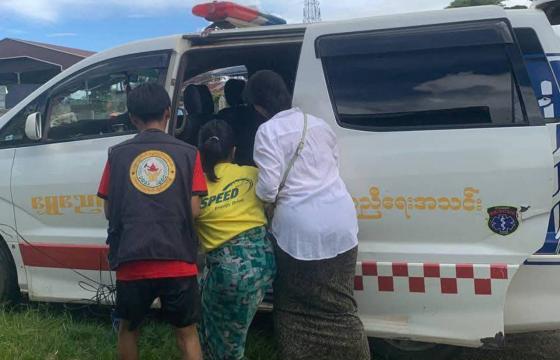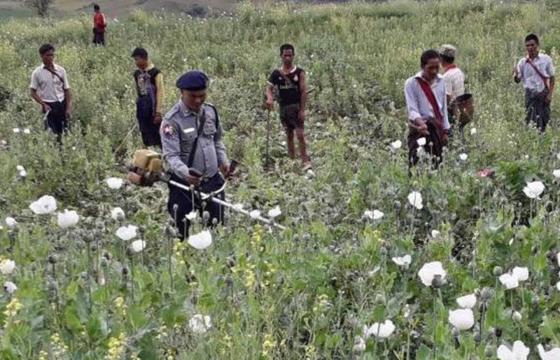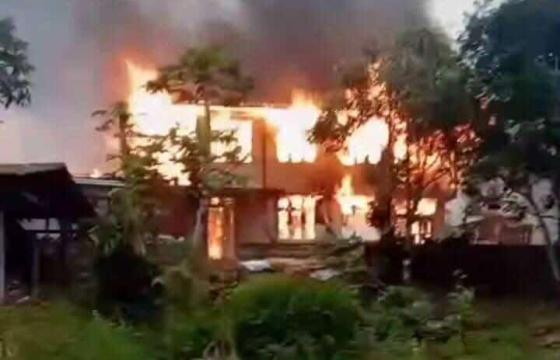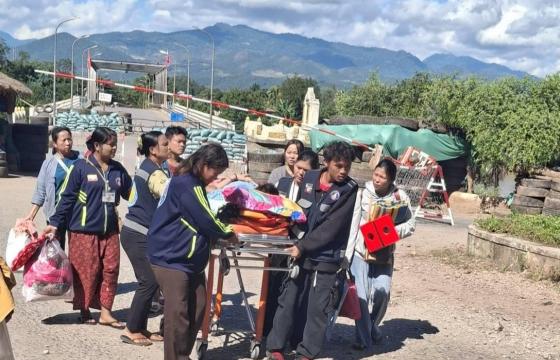“We let them in because the peace process between us and the Myanmar government will be damaged if there are gunshots and artillery fire. So, we let them in. We withdrew,” U Kyaw Wan Sein said, who is member of the NSCN-K’s Central Executive Committee. He said some unarmed members of the group and the organization’s Peace Committee remain at the headquarters.
Many were surprised and wondered why the Myanmar military or Tatmadaw occupied the National Socialist Council of Nagaland-Khaplang (NSCN-K) headquarters without firing a shot in the Naga Self-Administered Zone of Sagaing Region on January 29, even though the relationship of both parties has been largely cordial and unproblematic since 2000. Informal ceasefire has been in place since 2001 and was later converted into a regional-level ceasefire on 9 April, 2012 at Hkamti.
The answer to this move could be a well coordinated move of India and Myanmar in trying to dilute the core aspiration of achieving a united Nagaland as a sovereign state which the successive Naga leadership have been striving for and push NSCN-K to tread the path of peaceful negotiation separately within the mold of regional autonomy with both countries short of an independent state status.
On January 29 a military column consisting of over 400 troops from six battalions led by the Hkamti District tactical commander under the Tatmadaw’s North-West Command took control of the NSCN-K’s headquarters in the village of Ta Ga in Nanyun Township.
“We let them in because the peace process between us and the Myanmar government will be damaged if there are gunshots and artillery fire. So, we let them in. We withdrew,” U Kyaw Wan Sein said, who is member of the NSCN-K’s Central Executive Committee. He said some unarmed members of the group and the organization’s Peace Committee remain at the headquarters.
The reason for such actions is explained by the Tatmadaw as the breaching of regional-level truce by the NSCN-K signed in April 2012.
The Office of the Commander-in-Chief of Defense Services on February 3 and 6 made a press release stating seizure of three outposts and two military training schools run by rebel groups fighting the Indian government in Assam and Manipur. It also seized small weapons and ammunition said the press release.
It accused the NSCN-K of allowing rebels against the Indian government to shelter in its areas and said it arrested six NSCN-K members together with two Assam and Manipur rebels. It claimed to have “evidence that Manipur and Assam insurgents resided in the area and relevant documents on their links with the NSCN-K.” The Tatmadaw therefore said the NSCN-K violated the first article of the bilateral ceasefire agreement signed with the Sagaing Region government in April 2012 and said necessary actions would be taken.
But it is a known fact within the radius of 10 kilometers of NSCN-K headquarters that groups from the India’s North East such as the United Liberation Front of Assam (ULFA), People’s Liberation Army, United National Liberation Front, People’s Revolutionary Party of Kangleipak and others are located and have joined hands with NSCN-K.
According to Hindustan Times, nine militant groups of the northeast, including the NSCN-K and the ULFA faction led by Paresh Baruah, have come together to form a new unified front called “United National Liberation Front of West South East Asia” in Myanmar which happened shortly after the S S Khaplang, chairman of the NSCN-K abrogation of a 14-year-old ceasefire agreement with Indian government in 2015.
However, U Kyaw Wan Sein, a member of the NSCN-K’s Central Executive Committee said that there has been no violation and they have tried their best to maintain peace and the ceasefire agreement. He emphasized that they don’t want to see the destruction of the trust between them and the Tatmadaw that have taken so long to build up and don’t understand what the Tatmadaw means.
He declined to comment on the activities of the Assam and Manipur rebels, but would not deny that there are some groups trying to operate in the area, given its geographical proximity to India’s northeastern states.
Background
The NSCN was formed in 1980 with the mandate to pursue the struggle for freedom. The NSCN refused to accept incorporation into India and continues to strive for the independence of Nagaland.
Prime Minister Narasimha Rao offered to hold unconditional talks since February 23, 1996 to the various Naga factions to be engaged in peace talks with the Indian government for political settlement.
The NSCN-K was formed in 1988 after one of its founder-leaders, Shangwang Shangyung Khaplang, fell out with his fellow Indian Naga rebel leaders, Isak Chishi Swu and Thuingaleng Muivah, and violently broke away from the principal outfit, NSCN. Isak and Muivah continued to run their own faction in India, the NSCN-IM, while Khaplang crossed over to Myanmar and formed his own group. NSCN-K has a regional-level ceasefire agreement with the Tatmadaw since April 2012. But it is also officially at war with the Indian government following the abrogation of its ceasefire deal with New Delhi in 2015.
The NSCN-IM entered into a ceasefire agreement in 1997 with the Indian government and has maintained it since then. But the pact with NSCN-K was broken after the group attacked a military convoy in Manipur in June 2015, killing 18 soldiers.
The recent occupation of the NSCN-K headquarters is believed to pressure the group into signing the Nationwide Ceasefire Agreement (NCA) by choking its cross-border supply routes, including the sustained diplomatic pressure from New Delhi. On top of that the abrupt leadership change within the group must have also played an important role.
In August 2018 the People’s Council impeached new chairman Konyak for allegedly showing authoritarian impulses and was replaced by Khaplang’s nephew Yung Aung, who is a Naga from Burma side. Following this, Konyak and former NSCN-K commander Isak Sumi and other junior Naga leaders from India side crossed to India and formally joined the peace process with New Delhi on 29 January 2019. This, in many ways, marks the final break between the Burmese and Indian Naga rebels within NSCN-K, a convenient arrangement for both the Indian and Myanmar governments, wrote Asia Times in its recent report.
A coordinated ploy?
It is hard to say that whether the move of Tatmadaw to occupy the NSCN-K headquarters and clearance of the Manipur and Assam groups allied to the NSCN-K from the area is a coordinated action between India and Myanmar governments. But it is definitely aimed at diluting the political aspirations of the Naga as a whole into accepting a regional autonomy settlement instead of an original independent sovereign state goal, in both countries.
And as far as Myanmar is concerned pushing the NSCN-K to sign the NCA will bolster the stagnated peace process which has been stalled since last November when the largest two signatory Ethnic Armed Organizations (EAOs) opted to pull out of the negotiation which still cannot be restarted until today.
With the split of the NSCN-K into Indian and Myanmar factions and former joining the peace talks together with the NSCN-IM with the Indian government on 29 January 2019, the political scenario might have been drastically changed.
For the Myanmar side, speculations are that a more homogeneous Naga from Myanmar side would drop the demand for a trans-border sovereign Naga homeland and would have no choice but to join the NCA-based peace process for more regional autonomy. The Nagas from Indian side which insisted on independence is considered a hindrance for Myanmar to achieve political settlement.
As for New Delhi, the separation of India-based Naga rebel leaders from the NSCN-K and integration into the formal peace process in India would not have to deal directly with NSCN-K. Furthermore, the voluntary entry of Konyak and Sumi, the two militant leaders India had been pursuing for a long time, into negotiations bolsters the government’s credibility before it goes to an election in a few months, wrote Asia Times in its report recently.
AA factor
Another speculation for the Tatmadaw’s move against NSCN-K could be because of consideration to preempt uncooperative tendency which might arise from the part of Indian government.
According to recent report in The Irrawady Burmese version political analyst Maung Maung Soe said: “If we don’t clear Assam and Manipur rebels on our side, there are worries that India could also refuse to help in the case of Arakan Army (making use of Indian territory).”
He stressed: “Because such problems usually happened at the Thai border,” meaning anti-government ethnic armed groups making use of Thailand as sanctuary and resistance staging ground.
Outlook
Looking at the unfolding political scenarios, it is too early to draw any conclusion on whether the latest Tatmadaw’s move of NSCN-K headquarters occupation will produce a positive result for Myanmar and as well India.
For now the NSCN-K is bargaining with the Tatmadaw to withdraw from its headquarters and the latter is tight-lipped on what it has in store, not to mention the group signing the NCA anytime soon.
Nevertheless, Konyak and former NSCN-K commander Isak Sumi and other junior Naga leaders from India side joining the peace talks is a plus sign for Indian government, even though the negotiation process is far from over.
Either way, the Tatmadaw’s move which could be seen as pressuring the Naga to wind down a notch from their original political aspirations of independence and join the NCA-based peace process are achievable or not is an open question. And this assumption may well be true for the Indian government as well.







